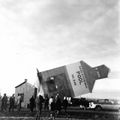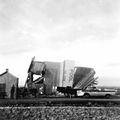Govenlock, SK: Difference between revisions
StevenBrown (talk | contribs) (Created page with "{{FL-Details|category=GhostTown}} {{FL-Location|LLL=SW S23 T03 R29 W3M|RM=51 - Reno|GPS=49.224538,-109.810895}} == Photos == <gallery> </gallery>") |
StevenBrown (talk | contribs) No edit summary |
||
| (One intermediate revision by the same user not shown) | |||
| Line 1: | Line 1: | ||
{{FL-Details|category=GhostTown}} | {{FL-Details|category=GhostTown}} | ||
Source: Wikipedia | |||
http://en.wikipedia.org/wiki/Govenlock,_Saskatchewan | |||
Source: http://www.ghosttownpix.com/sask/towns/govenloc.shtml | |||
Spirits were always high at the end of the Canadian Pacific Railway line at Govenlock in the far southwest corner of Saskatchewan. The trains went no further - until well after the First World War when the line linked up with Manyberries in southeast Alberta. | |||
Farmers cheerfully brought their grain to the station. Grateful bootleggers and local liquor warehouse businessmen eagerly picked their stock up at the station. | |||
In Govenlock's pioneer days, scores of thirsty Americans from Montana eagerly, and repeatedly, met the incoming trains after a long arduous journey across the border, and north up the dusty trails following their state's prohibition declaration in 1919. Often braving rumrunning outlaws - some who didn't think twice of hijacking their valuable stock, the Montana booze traders headed back across the border to Havre, particularly to the "underground mall" where prohibition had sent good times down below the streets. The turn-of-the-century honky tonk speakeasies were packed with wild cowboys and thirsty miners, letting loose with good old-fashioned frontier rot-gut from north of the border, and maybe a further trip to an opium den and bordello. | |||
For a few years, Govenlock was the important link for the revelry south of the border. The town boomed while fueling the whiskey trade. But the good times were not to last. | |||
Govenlock's humble beginnings began in 1910 when Moose Jaw resident William Govenlock applied for a homestead in the area. When he moved his family, they became one of the district's first pioneer families. | |||
In 1913, William Govenlock negotiated a land sale agreement with the CPR for the construction of a townsite. It was agreed by most settlers in the area that the name of the new settlement should be called Govenlock. The new country post office in the town was operated by Govenlock's wife, Bessie. | |||
Even without the steady flow of liquor, Govenlock's early beginnings looked promising. The town boasted its impressive CPR station, section house, grain elevators, two general stores, blacksmith shops, a livery barn, two machine agencies, pool room, laundry, school, meant shop, a service station selling Model T Fords, and a hotel. Most of these businesses were connected by wooden sidewalks, a common feature in the pioneer prairie days. | |||
The two-story 10-bedroom Govenlock Hotel was built in 1914 by John Lindner. Three years later, James Gaff stopped at the hotel for a rest, and when he was told there was no rooms available that night, he made an immediate deal with Lindner and promptly bought it for $4,500. | |||
Govenlock's early days looked promising. The pioneer town even had a Chamber of Commerce. But it was liquor that fueled Govenlock's pioneer commerce. At least four liquor warehouses were established to serve the booming prohibition trade. And with liquor, there was gambling and parties, attracting not only the thirsty folks from across the border, but many bachelors from all parts of southwestern Saskatchewan who wanted to let loose. | |||
"We'd like to meet the girl in Govenlock," recalled Paul Kalmring, a musician and store owner from nearby Senate. "The bachelors in the area had nothing to do so they'd take the train to Govenlock, play poker all night at the pool room." | |||
The pool room and dance hall was a two-story building, built and owned by Henry Buss. In the early days, it was a place for the Americans to meet and relax. While waiting for their liquor orders, many dropped in, mingled with the local business crowd, and settled down for a good game of pool, and a game of high-stakes poker. | |||
The revelry and good times were constants in Govenlock's early days, and so was the sight of eager booze traders. Americans came to town in their Fords, Packards, Hudsons and Studebakers. In order to avoid suspicion when riding empty of booze, each car's rear was loaded down with sand bags until each vehicle was filled at Govenlock's liquor export houses. The highly-prized 12 per cent Canadian beer came in a barrel. Each barrel had three burlap sacks, with 24 four-quart bottles - wrapped in straw - in each sack. A barrel wholesaled for $24. When it reached the United States, it sold for $140. A carload of 14 barrels of beer and five cases of whisky could fetch a profit of $2,500. | |||
For a few years, the bootlegging trade was good business, with few legal hassles for the rumrunners. Mounties and provincial police intervened only to ensure that none of the liquor ended up in local hands before it crossed the U.S. border. A few Govenlock residents tried bootlegging but soon found more was stolen than they could actually sell. As long as the bootleggers obtained a tourist pass at Canadian entry border points, they had few if any legal problems. | |||
However, the booze-fueled prosperity ended abruptly in 1922 when the Saskatchewan government announced it wanted better control of the liquor trade and restricted liquor export houses to cities with 10,000 people or more. It was the beginning of the end for Govenlock. One by one stores closed and residents left. In 1962, Govenlock's grain elevator was toppled and demolished. In 1990, most of the remaining buildings - including the Govenlock Hotel - were bulldozed. Today, only the community hall - built in 1948 - and a commemorative plaque mark Govenlock, and its past wild, wild spirit from the hell-raising pioneer days. | |||
{{FL-Location|LLL=SW S23 T03 R29 W3M|RM=51 - Reno|GPS=49.224538,-109.810895}} | {{FL-Location|LLL=SW S23 T03 R29 W3M|RM=51 - Reno|GPS=49.224538,-109.810895}} | ||
== Photos == | == Photos == | ||
<gallery> | <gallery> | ||
CA-SK-RM51-Govenlock-001.jpg | |||
CA-SK-RM51-Govenlock-002.jpg | |||
CA-SK-RM51-Govenlock-003.jpg | |||
CA-SK-RM51-Govenlock-004.jpg | |||
CA-SK-RM51-Govenlock-005.jpg | |||
CA-SK-RM51-Govenlock-006.jpg | |||
CA-SK-RM51-Govenlock-007.jpg | |||
CA-SK-RM51-Govenlock-008.jpg | |||
</gallery> | </gallery> | ||
Latest revision as of 22:40, 4 November 2018
Details
Source: Wikipedia http://en.wikipedia.org/wiki/Govenlock,_Saskatchewan
Source: http://www.ghosttownpix.com/sask/towns/govenloc.shtml
Spirits were always high at the end of the Canadian Pacific Railway line at Govenlock in the far southwest corner of Saskatchewan. The trains went no further - until well after the First World War when the line linked up with Manyberries in southeast Alberta.
Farmers cheerfully brought their grain to the station. Grateful bootleggers and local liquor warehouse businessmen eagerly picked their stock up at the station.
In Govenlock's pioneer days, scores of thirsty Americans from Montana eagerly, and repeatedly, met the incoming trains after a long arduous journey across the border, and north up the dusty trails following their state's prohibition declaration in 1919. Often braving rumrunning outlaws - some who didn't think twice of hijacking their valuable stock, the Montana booze traders headed back across the border to Havre, particularly to the "underground mall" where prohibition had sent good times down below the streets. The turn-of-the-century honky tonk speakeasies were packed with wild cowboys and thirsty miners, letting loose with good old-fashioned frontier rot-gut from north of the border, and maybe a further trip to an opium den and bordello.
For a few years, Govenlock was the important link for the revelry south of the border. The town boomed while fueling the whiskey trade. But the good times were not to last.
Govenlock's humble beginnings began in 1910 when Moose Jaw resident William Govenlock applied for a homestead in the area. When he moved his family, they became one of the district's first pioneer families.
In 1913, William Govenlock negotiated a land sale agreement with the CPR for the construction of a townsite. It was agreed by most settlers in the area that the name of the new settlement should be called Govenlock. The new country post office in the town was operated by Govenlock's wife, Bessie.
Even without the steady flow of liquor, Govenlock's early beginnings looked promising. The town boasted its impressive CPR station, section house, grain elevators, two general stores, blacksmith shops, a livery barn, two machine agencies, pool room, laundry, school, meant shop, a service station selling Model T Fords, and a hotel. Most of these businesses were connected by wooden sidewalks, a common feature in the pioneer prairie days.
The two-story 10-bedroom Govenlock Hotel was built in 1914 by John Lindner. Three years later, James Gaff stopped at the hotel for a rest, and when he was told there was no rooms available that night, he made an immediate deal with Lindner and promptly bought it for $4,500.
Govenlock's early days looked promising. The pioneer town even had a Chamber of Commerce. But it was liquor that fueled Govenlock's pioneer commerce. At least four liquor warehouses were established to serve the booming prohibition trade. And with liquor, there was gambling and parties, attracting not only the thirsty folks from across the border, but many bachelors from all parts of southwestern Saskatchewan who wanted to let loose.
"We'd like to meet the girl in Govenlock," recalled Paul Kalmring, a musician and store owner from nearby Senate. "The bachelors in the area had nothing to do so they'd take the train to Govenlock, play poker all night at the pool room."
The pool room and dance hall was a two-story building, built and owned by Henry Buss. In the early days, it was a place for the Americans to meet and relax. While waiting for their liquor orders, many dropped in, mingled with the local business crowd, and settled down for a good game of pool, and a game of high-stakes poker.
The revelry and good times were constants in Govenlock's early days, and so was the sight of eager booze traders. Americans came to town in their Fords, Packards, Hudsons and Studebakers. In order to avoid suspicion when riding empty of booze, each car's rear was loaded down with sand bags until each vehicle was filled at Govenlock's liquor export houses. The highly-prized 12 per cent Canadian beer came in a barrel. Each barrel had three burlap sacks, with 24 four-quart bottles - wrapped in straw - in each sack. A barrel wholesaled for $24. When it reached the United States, it sold for $140. A carload of 14 barrels of beer and five cases of whisky could fetch a profit of $2,500.
For a few years, the bootlegging trade was good business, with few legal hassles for the rumrunners. Mounties and provincial police intervened only to ensure that none of the liquor ended up in local hands before it crossed the U.S. border. A few Govenlock residents tried bootlegging but soon found more was stolen than they could actually sell. As long as the bootleggers obtained a tourist pass at Canadian entry border points, they had few if any legal problems.
However, the booze-fueled prosperity ended abruptly in 1922 when the Saskatchewan government announced it wanted better control of the liquor trade and restricted liquor export houses to cities with 10,000 people or more. It was the beginning of the end for Govenlock. One by one stores closed and residents left. In 1962, Govenlock's grain elevator was toppled and demolished. In 1990, most of the remaining buildings - including the Govenlock Hotel - were bulldozed. Today, only the community hall - built in 1948 - and a commemorative plaque mark Govenlock, and its past wild, wild spirit from the hell-raising pioneer days.
Location
| Land Location | SW S23 T03 R29 W3M |
| Rural Municipality | 51 - Reno |
| GPS Location | 49° 13' 28.34" N, 109° 48' 39.22" W |






